You’ll discover that Mississippi’s 240 to 300-day growing season creates perfect conditions for stunning native plants that’ll transform your landscape. The state’s humid subtropical climate, with its rich, moisture-retentive soils, supports everything from eye-catching wildflowers to majestic canopy trees. These hardy species aren’t just beautiful—they’re specifically adapted to handle Mississippi’s unique weather patterns, requiring less maintenance than exotic alternatives. What you might not realize is how these plants can dramatically reduce your gardening workload while creating a wildlife haven that’ll surprise you.
Contents
- 1 Mississippi’s Humid Subtropical Environment
- 2 Mississippi’s Best Native Blooms
- 3 Mississippi’s Native Shade Trees
- 4 Mississippi’s Hardy Native Shrubs
- 5 Selecting the Right Native Plants for Your Garden
- 6 Frequently Asked Questions
- 6.1 How Much Do Native Mississippi Plants Typically Cost Compared to Non-Native Varieties?
- 6.2 When Is the Best Time of Year to Plant Native Species?
- 6.3 Where Can I Purchase Native Mississippi Plants in My Local Area?
- 6.4 How Long Does It Take for Native Plants to Become Established?
- 6.5 Do Native Plants Require Special Soil Preparation or Fertilizers?
Mississippi’s Humid Subtropical Environment
Since Mississippi sits squarely in the humid subtropical zone, you’ll deal with long, sweltering summers and surprisingly mild winters that rarely bite hard. Summer temperatures hover between 88°F to 92°F, while winter lows seldom dip below 30°F in southern areas. Your growing season stretches an impressive 240 to 300 days, giving you plenty of time for climate adaptation strategies.
You’ll receive 50-65 inches of annual rainfall, with wettest periods hitting late winter and spring. Most summer rainfall occurs during thunderstorms due to intense surface heating. This abundance creates soil management challenges, especially with clay-heavy regions that drain poorly and stay waterlogged, requiring raised beds.
Mississippi’s Best Native Blooms
Mississippi’s diverse native wildflowers offer stunning beauty throughout growing seasons, from early spring blooms and vibrant summer displays to shade-loving varieties and specialized plants supporting local wildlife. These low-maintenance plants naturally adapt to local soil and climate conditions, requiring less fertilizer, pest control, and watering than non-native species.
Wild Bergamot (Monarda Fistulosa)

Wild Bergamot (Monarda fistulosa) is a striking native perennial that brings both beauty and ecological value to Mississippi gardens. This aromatic member of the mint family produces distinctive pompom-like flower heads in shades of white, pink, or lavender-purple from May through September. Growing 2-5 feet tall with gray-green, mint-scented foliage, Wild Bergamot thrives throughout Mississippi’s diverse landscapes.
Beyond its ornamental appeal, Wild Bergamot serves as a pollinator magnet, attracting monarchs, swallowtails, native bees, and hummingbirds. Its tubular flowers provide excellent nectar sources, making it invaluable for pollinator gardens and restoration projects. The plant’s historical significance as a medicinal tea and its drought tolerance once established make it an ideal choice for low-maintenance native plantings. The fragrant leaves can also be harvested to create natural perfume blends.
- Hardiness: USDA zones 3-10
- Light: Full sun to partial shade
- Water: Low to moderate; drought-tolerant once established
- Soil: Well-drained, adaptable to various soil types; pH 6-8
- Fertilizer: None required; thrives in poor soils
- Pest/Disease Resistance: Generally resistant; may experience powdery mildew in humid conditions
- Growth Rate: Moderate; spreads by rhizomes
Cardinal Flower (Lobelia Cardinalis)

Cardinal Flower (Lobelia cardinalis) stands out as one of Mississippi’s most spectacular native wildflowers, producing brilliant red spike-shaped blooms that rise 2-4 feet tall against striking green and purple-bronze foliage. This moisture-loving perennial naturally thrives in the state’s wet meadows, stream banks, and marsh edges, where its tubular scarlet flowers bloom from bottom to top throughout late summer. The five-petaled flowers form a distinctive two-lipped corolla that serves as a primary nectar source for hummingbirds and butterflies from July through September.
As a true southern native, Cardinal Flower has adapted perfectly to Mississippi’s climate and growing conditions. Its long blooming period and deer-resistant qualities make it an excellent choice for naturalized areas, rain gardens, or pond margins where consistent moisture can be maintained. The plant’s architectural flower spikes provide dramatic vertical interest in the landscape, while its specialized tubular flower structure creates an important ecological link between native plants and their primary pollinators. Beyond its ornamental value, the brilliant red blooms serve as excellent cut flowers that bring the beauty of native Mississippi wildflowers indoors.
- Hardiness: USDA zones 3-9, well-suited to Mississippi climate
- Light: Full sun to part shade, ideal in filtered light
- Water: Requires consistently moist to wet soil conditions
- Soil: Prefers moist, sandy, loamy soil rich in organic matter
- Fertilizer: Minimal requirements in organically rich native soils
- Pest/Disease Resistance: Deer resistant, few serious pest issues
- Growth Rate: Medium rate, reaching 3 feet tall by 1 foot wide
Purple Coneflower (Echinacea Purpurea)
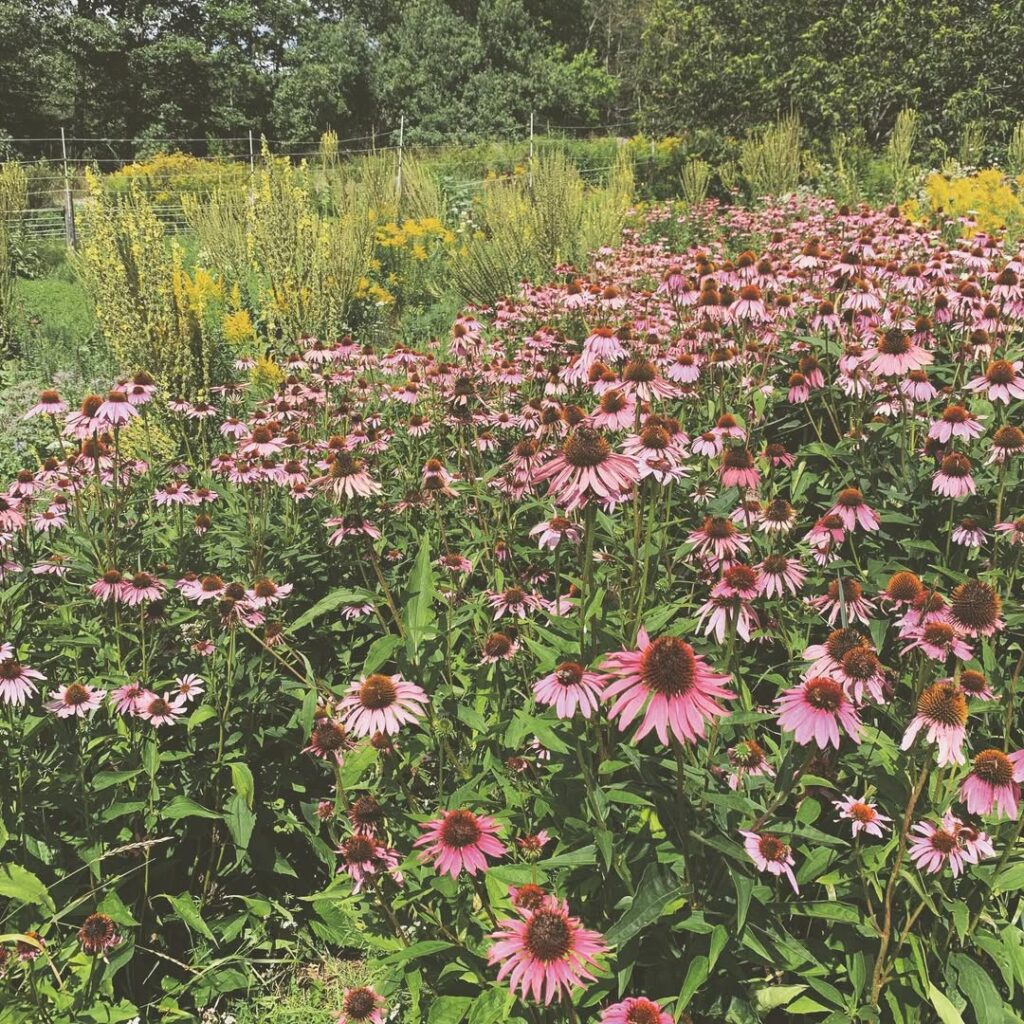
Purple Coneflower (Echinacea purpurea) stands as one of Mississippi’s most beloved native wildflowers, showcasing striking cone-shaped blooms with vibrant purple petals surrounding prominent dark centers. This herbaceous perennial reaches 2-4 feet in height and features alternate, toothed leaves that decrease in size toward the stem tops.
Native throughout Mississippi’s prairies and open woodlands, Purple Coneflower blooms from June through August, producing long-lasting lavender flowers that attract butterflies and bees. The plant thrives in the state’s well-drained soils and has been valued historically by Native Americans and settlers for medicinal purposes, while today serving as both a popular garden perennial and essential pollinator habitat. In Mississippi’s climate, these hardy perennials may need replacement after a few years due to crown rot issues caused by the state’s cool, damp winters.
- Hardiness: Zones 3-9, cold hardy perennial
- Light: Full sun preferred, tolerates partial shade
- Water: Drought tolerant once established, moderate watering
- Soil: Well-drained soils, tolerates poor conditions
- Fertilizer: Low requirements, avoid over-fertilizing
- Pest/Disease Resistance: Generally pest and disease resistant
- Growth Rate: Moderate growth rate, spreads naturally
Black-Eyed Susan (Rudbeckia Hirta)
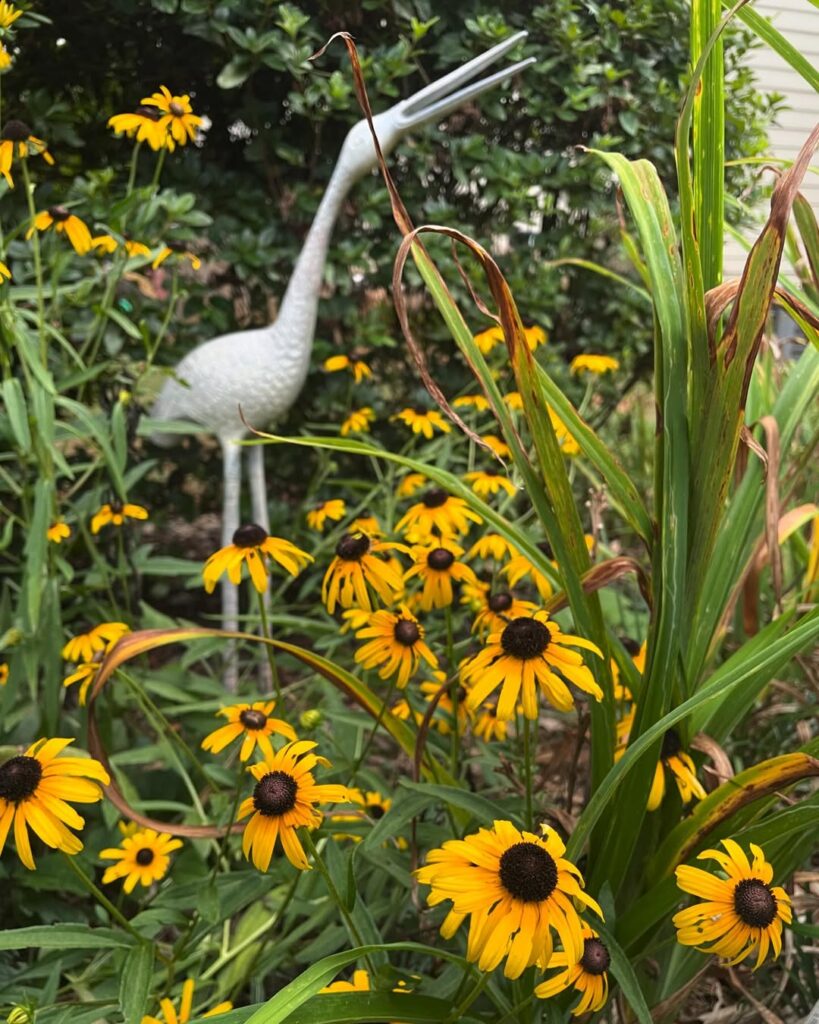
Black-eyed Susan (Rudbeckia hirta) stands as one of Mississippi’s most beloved native wildflowers, delivering vibrant yellow to orange daisy-like blooms from early summer through fall. This versatile member of the Asteraceae family thrives as an annual, biennial, or short-lived perennial, typically reaching 2-3 feet in height with distinctive dark, button-shaped centers surrounded by cheerful petals.
Beyond its ornamental appeal, Black-eyed Susan serves as a vital pollinator magnet and butterfly host plant, supporting species like the Lined Emerald and Silvery Checkerspot while providing late-season seeds for birds. The cultivar ‘Indian Summer,’ recognized as a Mississippi Medallion winner in 1999, exemplifies the plant’s garden-worthy performance with larger, more striking blooms that enhance both naturalized meadows and formal perennial borders.
For successful propagation, Black-eyed Susan propagates easily from seeds sown in either fall or spring seasons. Seeds mature approximately 3-4 weeks after the flowering period ends, making collection timing straightforward for gardeners wanting to expand their plantings naturally.
- Hardiness: USDA zones 3-8
- Light: Full sun
- Water: Low to moderate; drought tolerant once established
- Soil: Well-drained loamy, sandy, or clay soil; prefers acidic pH below 6.8
- Fertilizer: Low fertility needs; minimal supplemental feeding required
- Pest/Disease Resistance: Generally resistant to major pests and diseases
- Growth Rate: Moderate to fast; blooms first year from seed
Swamp Sunflower (Helianthus Angustifolius)
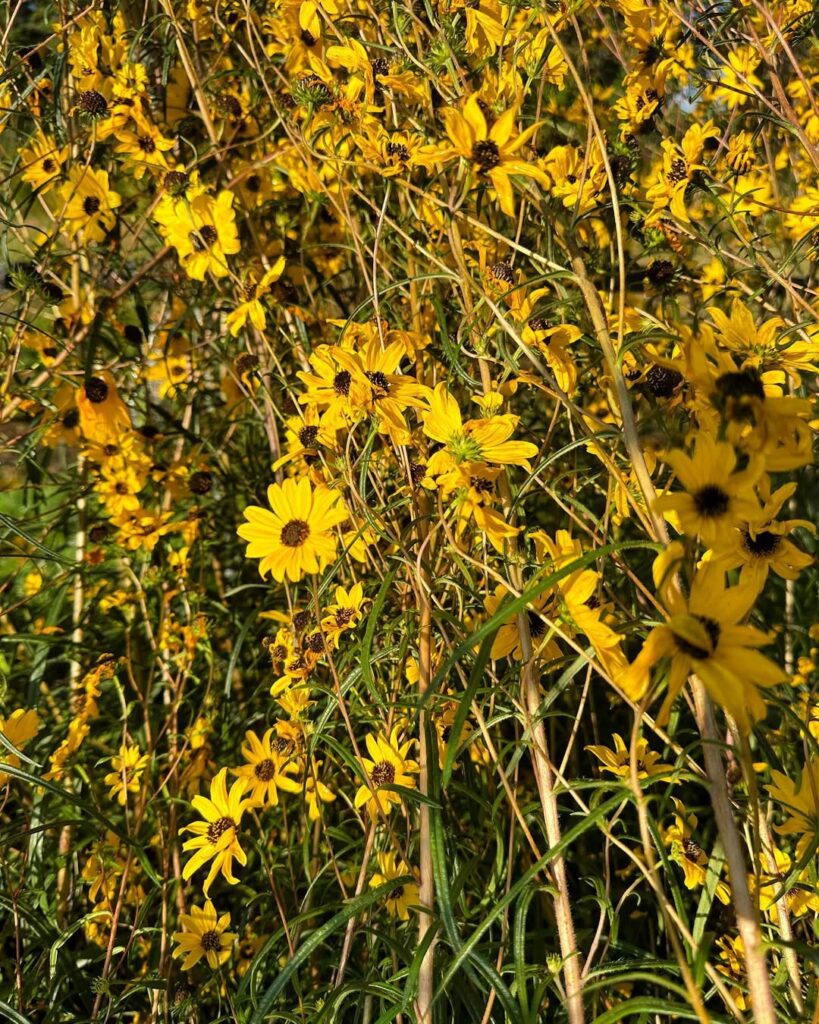
Swamp Sunflower (Helianthus angustifolius) is a striking native perennial that grows 3-6 feet tall with narrow, dark green leaves covered in stiff hairs. This Mississippi native produces brilliant yellow daisy-like flowers with dark centers that bloom from mid-summer through fall, providing essential late-season color when few other plants are flowering.
Thriving in wet, shady areas like flood plains and pond margins, Swamp Sunflower prefers moist conditions but adapts well to various soil types. Its impressive flower heads attract numerous pollinators and songbirds, making it an excellent choice for native gardens, naturalized areas, and back borders where its height and extended bloom period create maximum impact. The plant produces small cypsela fruits that provide food for wildlife after the blooming period ends.
- Hardiness: Native to Mississippi; cold hardy in USDA zones 6-9
- Light: Full sun to partial shade; flowers more profusely in full sun
- Water: Prefers consistently moist to occasionally wet conditions; adaptable to drier soils with adequate moisture
- Soil: Acidic sandy to clay loams; thrives in wet, boggy conditions
- Fertilizer: Low maintenance; typically requires no supplemental fertilization in native soils
- Pest/Disease Resistance: Generally resistant to most pests and diseases as a native species
- Growth Rate: Moderate; reaches mature height of 3-6 feet in one growing season
Mississippi’s Native Shade Trees
Mississippi’s diverse native shade trees offer excellent options for landscaping, from towering deciduous species with seasonal color to evergreen varieties providing year-round coverage and wildlife habitat. These trees are naturally better adapted to Mississippi’s acidic mineral soils compared to ornamental trees from other regions.
Southern Live Oak (Quercus Virginiana)
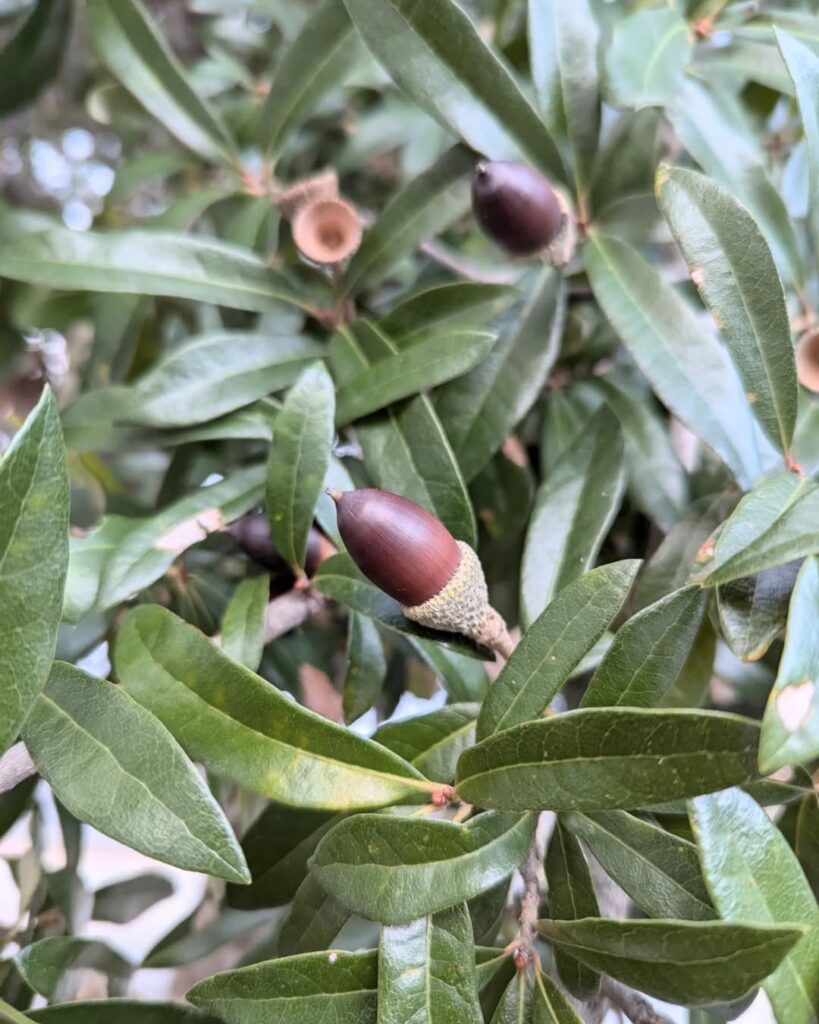
The Southern Live Oak (Quercus virginiana) is Mississippi’s quintessential native shade tree, renowned for its majestic, wide-spreading canopy and distinctive horizontal branching pattern. This evergreen oak can reach 40-80 feet in height with an impressive spread of up to 100 feet, making it an iconic feature of the Southern landscape.
Exceptionally long-lived with specimens over 400 years old documented, the Southern Live Oak thrives in Mississippi’s coastal plains and lowland woods. Its leathery, dark green leaves and dense canopy provide excellent shade, while its remarkable salt tolerance makes it valuable for coastal plantings. The tree produces small, clustered acorns that are a vital food source for species including bobwhite quail, Florida scrub jay, and wood duck. The tree’s fire-resistant qualities, due to crown and root survival capabilities, make it particularly well-suited for natural landscape settings.
- Hardiness: USDA zones 8a and warmer
- Light: Full sun to partial shade
- Water: Moderate; drought tolerant once established, requires occasional supplemental watering
- Soil: Tolerates various soil types including sandy, clay, and salty soils; prefers well-draining conditions
- Fertilizer: Minimal requirements; benefits from organic matter but not essential
- Pest/Disease Resistance: Generally resistant to most pests and diseases; very hardy species
- Growth Rate: Fast-growing when young with adequate moisture, slows with maturity
Bald Cypress (Taxodium Distichum)
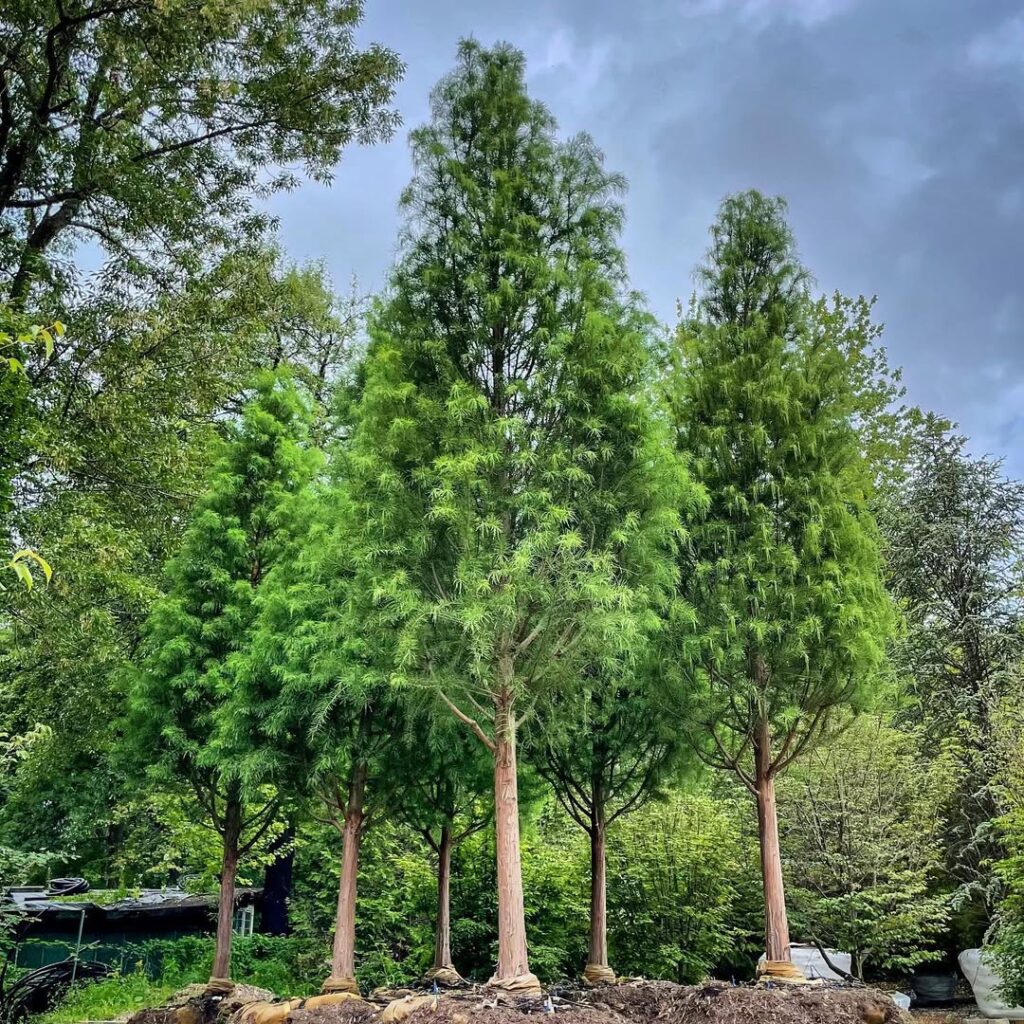
The Bald Cypress is Mississippi’s most iconic deciduous conifer, reaching impressive heights of up to 100 feet with distinctive woody “knees” projecting from its roots. This majestic native tree transforms from a pyramidal youth to a columnar form, displaying feather-like light green foliage that turns stunning copper-red each autumn before dropping.
Renowned for exceptional adaptability, the Bald Cypress thrives in both wetland and upland environments throughout Mississippi’s diverse landscapes. Its remarkable resilience allows it to withstand hurricane-force winds, seasonal flooding, and drought conditions, making it invaluable for wildlife habitat, erosion control, and ornamental landscaping. The durable wood has been prized for generations in boat building, exterior applications, and fence construction due to its superior resistance to decay. Some specimens in Mississippi exceed several hundred years old, with the state’s largest measuring nearly 47 feet in circumference.
- Hardiness: USDA zones 4-10, extremely cold and heat tolerant
- Light: Full sun preferred, tolerates partial shade
- Water: Highly adaptable from constantly wet/flooded to moderately dry conditions
- Soil: Thrives in acidic, wet to saturated soils; tolerates wide range including sandy, clay, and salty conditions
- Fertilizer: Low maintenance, rarely requires supplemental feeding in natural settings
- Pest/Disease Resistance: Excellent resistance to most pests and diseases; highly rot-resistant heartwood
- Growth Rate: Moderate to fast, especially in ideal wet conditions
Tulip Tree (Liriodendron Tulipifera)
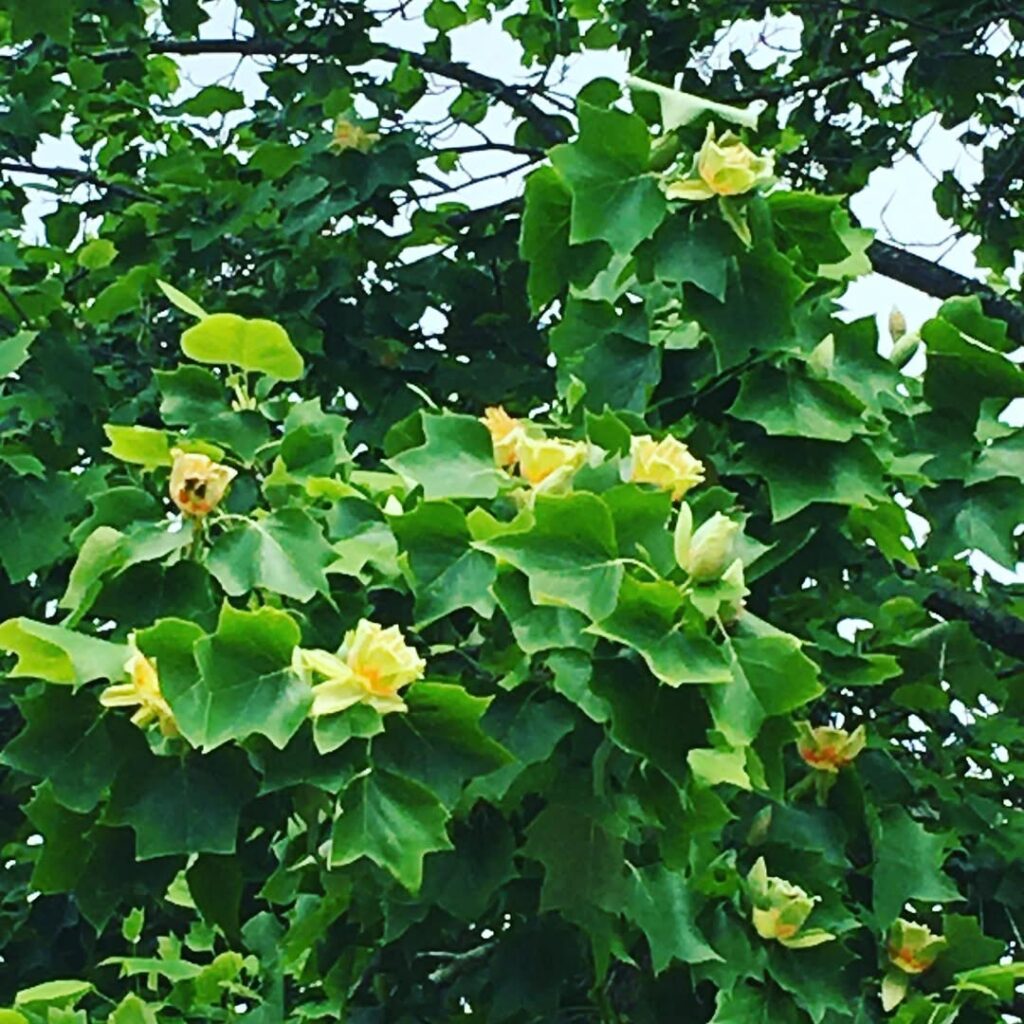
The Tulip Tree (Liriodendron tulipifera) stands as one of Mississippi’s most impressive native shade trees, capable of reaching towering heights over 160 feet in natural forests. This member of the Magnoliaceae family features distinctive star-shaped leaves that turn brilliant yellow in fall and produces unique greenish-yellow tulip-like flowers in April.
Known for its tall, straight trunk and pyramidal form, the Tulip Tree can grow limbless for 80-100 feet before branching. Despite its fast growth rate, it produces strong wood classified as “midwood” rather than traditional hardwood. The species thrives throughout Mississippi’s native deciduous forests and serves as the state tree for Indiana, Kentucky, and Tennessee. These impressive trees can live up to around 500 years, making them valuable long-term additions to the landscape.
- Hardiness: Native to eastern North America, well-adapted to Mississippi’s climate zones
- Light: Partial sun to shade exposure for ideal development
- Water: Moist soil conditions required for best growth performance
- Soil: Adaptable to various soil types with good drainage
- Fertilizer: Low maintenance once established in suitable conditions
- Pest/Disease Resistance: Generally problem-free with good natural resistance
- Growth Rate: Fast-growing species with strong wood development
Southern Magnolia (Magnolia Grandiflora)
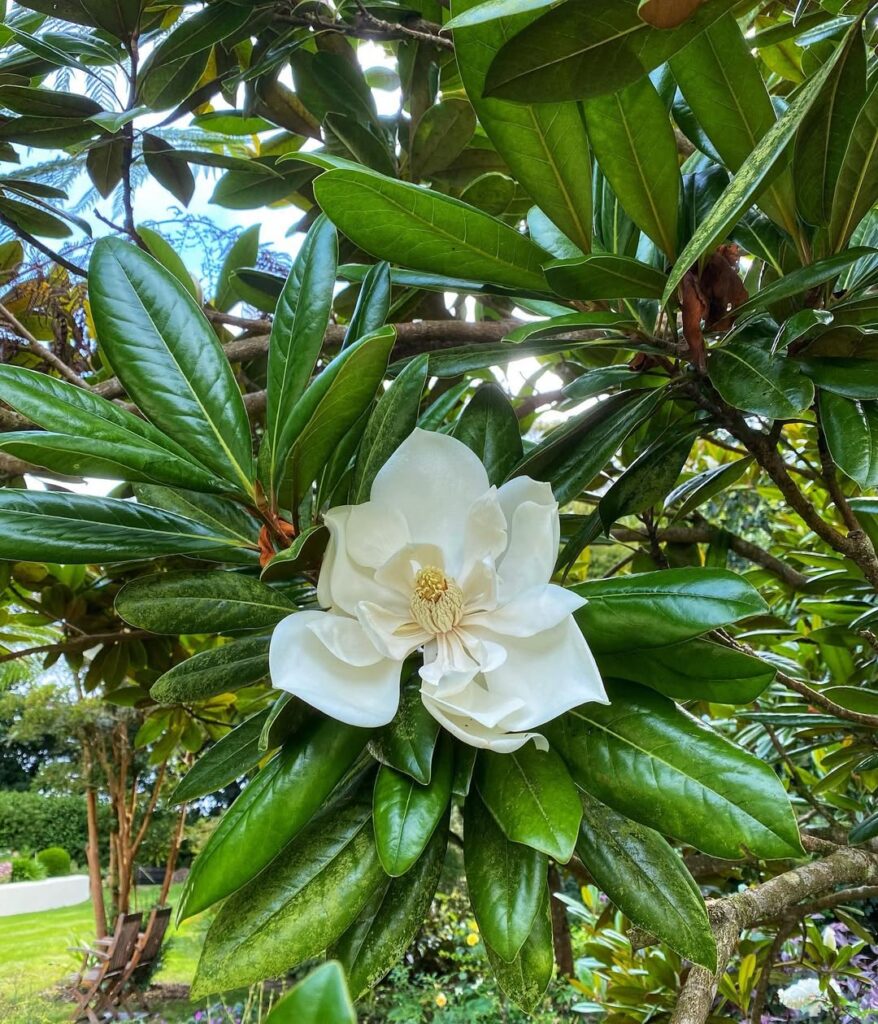
The Southern Magnolia stands as Mississippi’s official state tree, representing one of the most magnificent native evergreens in the Southeast. This pyramidal-shaped tree can reach heights of 100 feet, producing spectacular 6-inch white fragrant flowers from April through June. Native to bottomlands and low uplands of the Coastal Plains, it thrives alongside sweetgum, water oak, and black tupelo.
As a moderately fast-growing specimen, Southern Magnolia develops an extensive root system and dense canopy that provides excellent screening. While it casts heavy shade and produces persistent fallen leaves requiring maintenance, it remains relatively pest-free and adaptable to various soil types when provided with adequate moisture and protection from harsh winter conditions. The distinctive flowers follow a daily pattern, opening around 9:00 A.M. and closing at night for 2-3 days before disintegrating.
- Hardiness: Zones 6-10, requires winter protection in northern range
- Light: Shade tolerant when young, prefers partial to full sun at maturity
- Water: Moderate to high moisture needs, well-drained soils, cannot tolerate flooding
- Soil: Rich, moist, well-drained acidic soils; adaptable to sandy, loam, or clay
- Fertilizer: Low maintenance once established in nutrient-rich soils
- Pest/Disease Resistance: Excellent, relatively pest-free compared to other landscape trees
- Growth Rate: Moderate to fast-growing
Red Maple (Acer Rubrum)
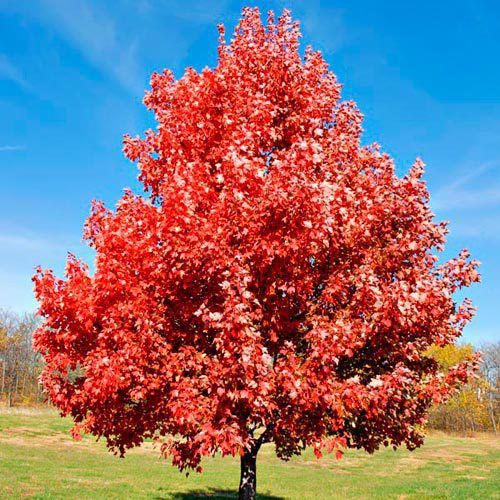
Red maple is a versatile native shade tree that can reach 90-100 feet tall with a distinctive vase shape and broad, rounded canopy. This deciduous tree offers year-round interest with bright red flowers in early spring, distinctive winged fruits, and spectacular fall foliage ranging from red to yellow. Known as “swamp maple,” it thrives in Mississippi’s diverse conditions from wet bottomlands to upland sites.
As both an early pioneer species and component of mature forests, red maple provides excellent wildlife value while serving as an attractive ornamental tree. Its shallow root system and fast growth rate make it ideal for quick shade, though care should be taken when planting near sidewalks or structures. The tree produces palmate leaves that are arranged oppositely on the branches, creating an attractive foliage pattern.
- Hardiness: Native throughout eastern United States including Mississippi
- Light: Full to partial sun
- Water: Tolerates wet to dry conditions; commonly found in moist soils along stream banks
- Soil: Wide range from clay to sandy loam; performs poorly in high pH soils
- Fertilizer: Benefits from organically-rich soil amendments in cultivation
- Pest/Disease Resistance: Generally hardy and prolific
- Growth Rate: Fast-growing
Mississippi’s Hardy Native Shrubs
Mississippi’s diverse climate supports numerous hardy native shrubs that thrive in varying conditions from wetlands to woodlands, offering exceptional wildlife value, seasonal interest, and low-maintenance landscaping solutions. These resilient plants adapt well to the state’s distinct soil types found across different ecoregions, from the sandy compositions of the Southeastern Plains to the alluvial deposits of the Mississippi River floodplain.
Spicebush (Lindera Benzoin)

Spicebush (Lindera benzoin) is a versatile native understory shrub that thrives throughout Mississippi’s diverse landscapes. Growing 6-12 feet tall and wide, this deciduous plant forms dense, spreading clumps with aromatic foliage and stems. In early spring, clusters of small pale-yellow flowers bloom before the leaves emerge, providing vital early-season nectar for pollinators.
This hardy shrub serves as the essential host plant for Spicebush Swallowtail butterflies and produces bright red berries on female plants that feed songbirds throughout fall. With glossy green summer foliage that turns golden yellow in autumn, spicebush offers four-season interest while supporting woodland ecosystems. Its aromatic qualities when crushed give it historical significance as wild allspice, making it both ecologically valuable and culturally relevant for Mississippi gardeners. The leaves and twigs can be brewed into a flavorful herbal tea, adding to its practical uses for home gardeners.
- Hardiness: USDA zones 4-9
- Light: Partial to full shade
- Water: Moist to wet, consistently moist preferred
- Soil: Fertile, loamy soils; adaptable to various soil types
- Fertilizer: None required; thrives in naturally rich woodland conditions
- Pest/Disease Resistance: Excellent; minimal pest and disease issues
- Growth Rate: Moderate; spreads via multiple stems to form colonies
American Beautyberry (Callicarpa Americana)
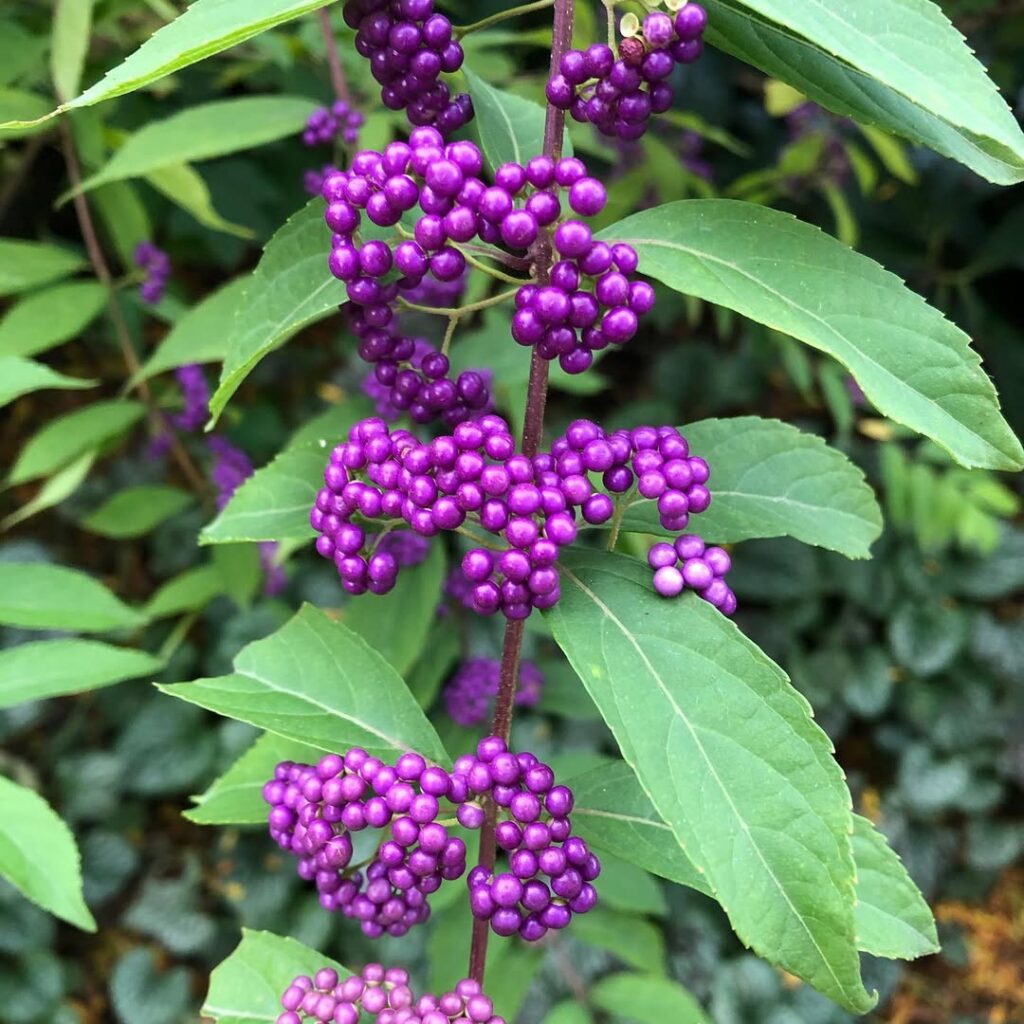
American Beautyberry (Callicarpa americana) is a striking deciduous shrub native to Mississippi’s woodlands and forest edges. Growing 3-5 feet tall with an open, arching habit, this hardy plant produces clusters of lavender-pink flowers in late spring followed by its signature vibrant magenta berries that persist through fall. The berries provide food for over 40 bird species while the flowers attract pollinators.
This low-maintenance shrub thrives in Mississippi’s heat and humidity, making it ideal for naturalized landscapes and wildlife gardens. Historically used by Native Americans for medicinal purposes and insect repelling, it remains valued today for its ornamental appeal and ecological benefits. The plant offers multi-season interest and exceptional pest resistance once established. With proper care and consistent soil moisture, multiple plants will produce the most abundant fruit displays.
- Hardiness: Zones 6-10, extremely tolerant of Mississippi’s heat and humidity
- Light: Partial shade to full sun; prefers partial shade but adapts well to full sun with adequate moisture
- Water: Moderate; prefers consistent moisture but tolerates some drought once established
- Soil: Adaptable to various soil types; performs best in well-drained, moist soils; thrives in rich bottomlands
- Fertilizer: Low requirements; benefits from organic matter but generally unnecessary in native settings
- Pest/Disease Resistance: Highly resistant to pests and diseases; very low maintenance
- Growth Rate: Moderate to fast; reaches mature size within 3-5 years under favorable conditions
Oakleaf Hydrangea (Hydrangea Quercifolia)

The Oakleaf Hydrangea (Hydrangea quercifolia) is a stunning deciduous shrub native to Mississippi’s upland regions, growing 10-12 feet tall with distinctive oak-shaped leaves up to 8 inches long. This hardy native produces creamy white panicle flowers that age to pink, then rusty-brown, persisting through fall. The deeply lobed foliage transforms to reddish bronze in autumn, providing exceptional seasonal interest.
Unlike other hydrangeas, flower color remains unaffected by soil pH. The plant spreads by stolons to form attractive colonies, making it ideal for natural screening and woodland gardens. The shrub’s distinctive exfoliating bark reveals rich brown inner layers on mature stems, adding winter interest to the landscape. As a drought-tolerant alternative to non-native shrubs, it offers multi-season beauty while supporting local pollinators and preserving Mississippi’s natural heritage.
- Hardiness: USDA zones 5-9
- Light: Partial shade to full sun; prefers some shade
- Water: Moderate; more drought-tolerant than other hydrangeas once established
- Soil: Well-draining, adaptable to various soil types
- Fertilizer: Minimal requirements; benefits from organic matter
- Pest/Disease Resistance: Good resistance with minimal maintenance needs
- Growth Rate: Moderate
Southern Wax Myrtle (Myrica Cerifera)
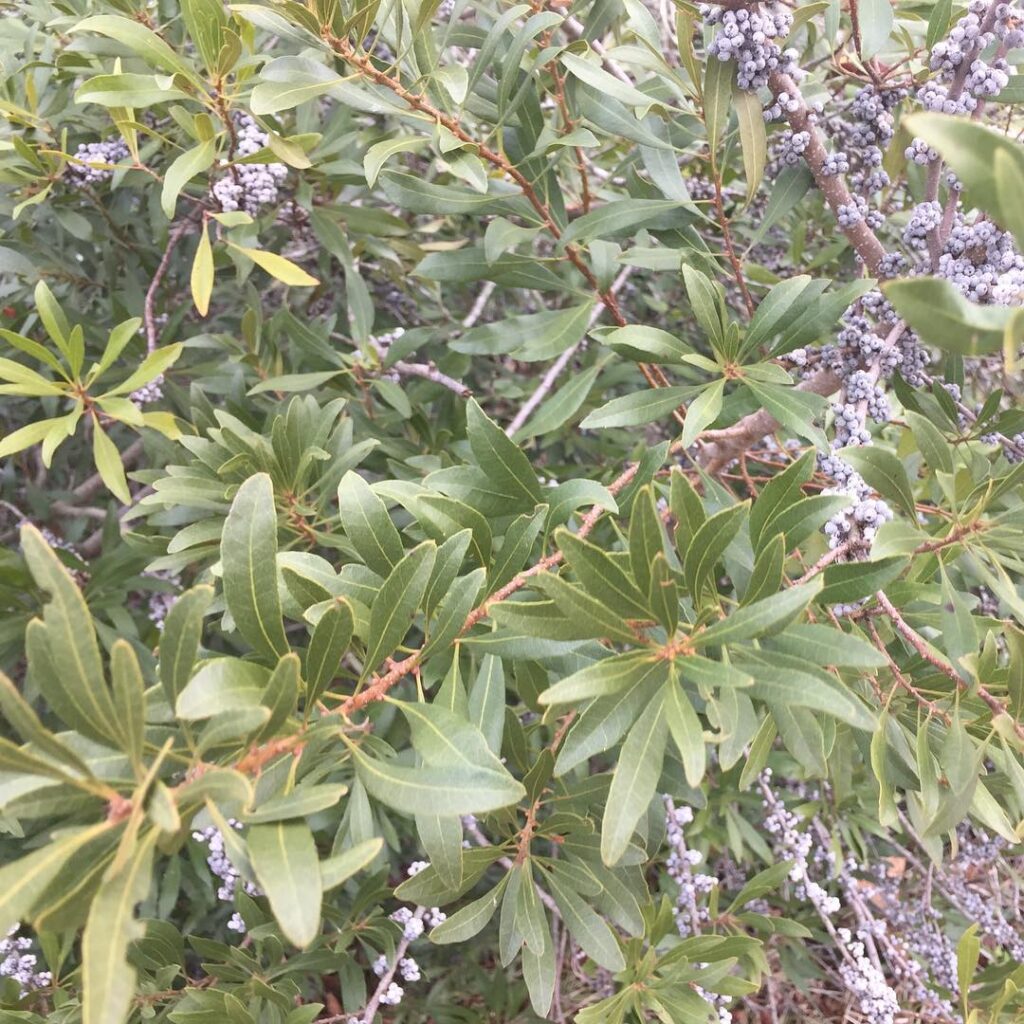
Southern Wax Myrtle is a versatile, multi-trunked evergreen shrub native to Mississippi and the broader Southeast. This hardy plant typically reaches 6-12 feet in height and produces aromatic, olive-green foliage with distinctive blue-gray berries on female plants. Its ability to spread through underground runners makes it excellent for forming natural privacy screens and windbreaks.
The species thrives in Mississippi’s diverse conditions, from moist forest edges to urban landscapes. Its nitrogen-fixing roots allow it to flourish in poor soils, while its extensive root system provides valuable erosion control. The waxy berries persist through winter, offering essential food sources for native wildlife, making it an ideal choice for both functional landscaping and habitat restoration projects. Historically, colonists utilized the waxy fruit coating to create fragrant-burning candles, earning it the common name Candleberry.
- Hardiness: USDA zones 7-11; may defoliate below 0°F but releafs in spring
- Light: Full sun to part shade
- Water: Moderate to high; tolerates both drought and flooding once established
- Soil: Adaptable to various soils from sands to clays; slightly acidic to neutral pH preferred
- Fertilizer: Minimal requirements due to nitrogen-fixing root nodules
- Pest/Disease Resistance: Excellent; minimal serious pest or disease problems
- Growth Rate: Rapid-growing; establishes quickly in suitable sites
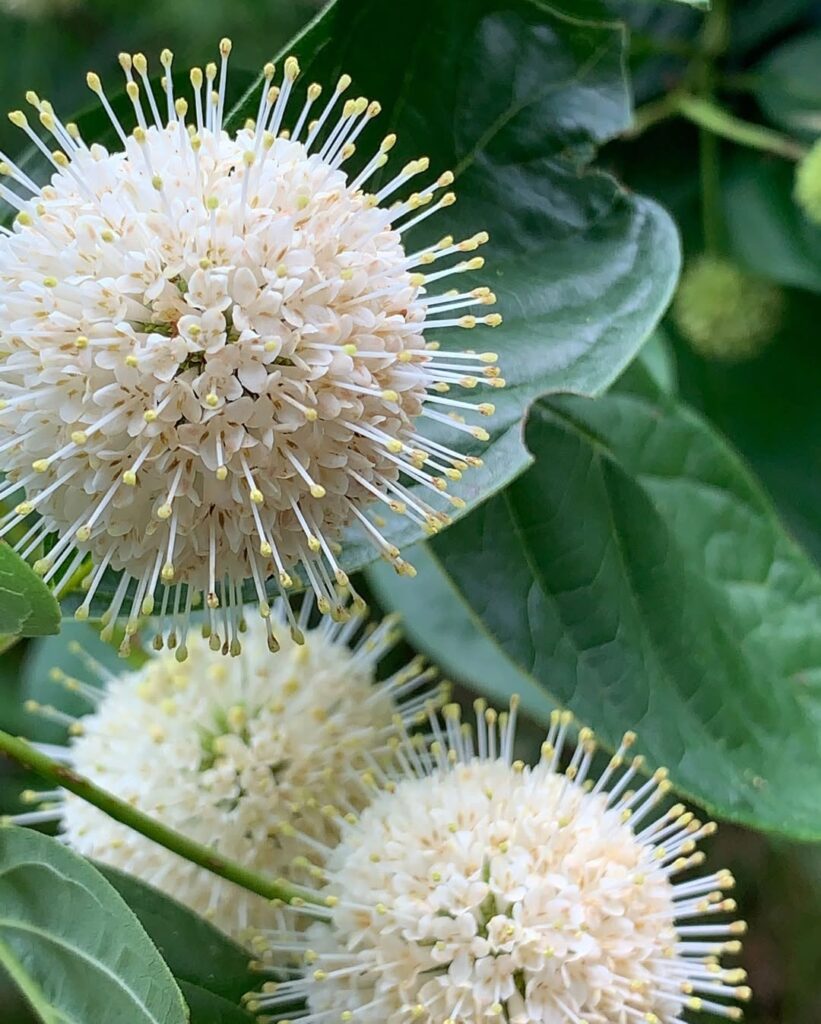
Buttonbush is a versatile native shrub that thrives in Mississippi’s wetland environments. This deciduous plant typically grows 6-12 feet tall with distinctive white, globe-shaped flower clusters that bloom from June to September, creating a striking pincushion appearance. The fragrant blooms and persistent brown fruit clusters provide year-round visual interest while supporting local wildlife.
This hardy shrub excels in consistently wet conditions, making it ideal for rain gardens, pond margins, and wetland restoration projects. Its extensive root system helps control erosion along streambanks while filtering water naturally. Buttonbush requires minimal maintenance once established and provides valuable habitat for pollinators, birds, and other wildlife throughout the growing season. The buttonbush seeds serve as an important food source for waterfowl species.
- Hardiness: Native to much of the United States including Mississippi; heat tolerant and adapted to fluctuating water levels
- Light: Full to partial sun; poor flowering occurs in shaded conditions
- Water: Prefers consistently moist to wet conditions; can tolerate standing water up to 3 feet deep
- Soil: Rich, wet soils; tolerates soil compaction but performs poorly in dry soils
- Fertilizer: No special fertilizer requirements when grown in suitable wet conditions
- Pest/Disease Resistance: Moderately resistant to deer browsing; generally pest and disease resistant
- Growth Rate: Vigorous growth under suitable conditions; multi-stemmed form allows dense development
Selecting the Right Native Plants for Your Garden
How do you choose native plants that’ll actually thrive in your Mississippi garden? Start with a thorough soil assessment, testing for drainage, pH levels, and clay content. Plant compatibility depends on matching species to your specific conditions—wet clay soils suit bald cypress, while sandy areas favor drought-tolerant options.
Consider your garden’s sun exposure throughout the day. Full-sun spots work for swamp sunflower, partial shade supports red buckeye beautifully. Layer different heights for visual appeal: tall river birch as backdrop, medium shrubs like beautyberry, then low perennials.
Group similar species together for maximum pollinator impact and easier maintenance. These native plant collections will also support local birds and small mammals, creating sustainable habitats in your backyard.
Frequently Asked Questions
How Much Do Native Mississippi Plants Typically Cost Compared to Non-Native Varieties?
You’ll pay through the nose for native Mississippi plants—expect cost comparison showing $12-18 per native versus $2.50 for non-natives. This price variation means doubling your initial investment compared to common alternatives.
When Is the Best Time of Year to Plant Native Species?
You’ll find spring planting works best for most native species, typically after your last frost date in March or April. Fall planting from September through early November also succeeds well for establishment.
Where Can I Purchase Native Mississippi Plants in My Local Area?
Finding native plants is like treasure hunting—you’ll discover gems at local nurseries such as Martinson’s Garden Works or Moore’s Greenhouse, plus online retailers like Garden for Wildlife offer ZIP-code-specific collections delivered statewide.
How Long Does It Take for Native Plants to Become Established?
Your native plants’ establishment timeline varies by species, with most requiring 1-3 years for full development. Annuals establish faster than perennials, while woody species have slower growth rates, taking 3-5 years to mature completely.
Do Native Plants Require Special Soil Preparation or Fertilizers?
Like Goldilocks finding the perfect porridge, you’ll discover native plants aren’t picky about soil amendments or fertilizer options. Simply add compost and they’ll thrive naturally without expensive treatments or constant feeding.
